|
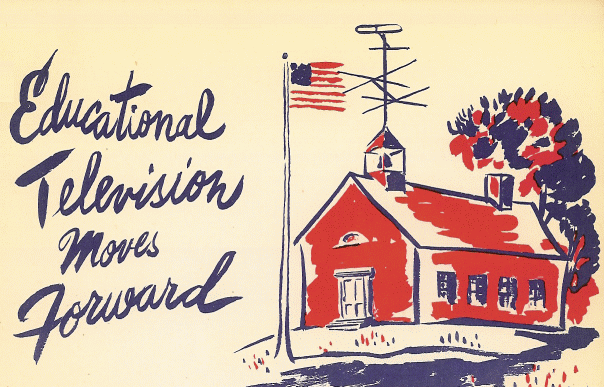
A REPORT
of a Full School Day of Ultra-High Frequency
Classroom Television Programs
in the Public Schools
OF BLOOMFIELD AND MONTCLAIR, N. J.
on April 30, 1952 |
|
The Montclair State Teachers College
Television in Education Project
Montclair, New Jersey |
|
|
| |
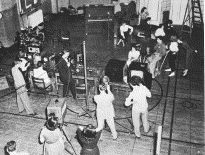
Photo by Robert Finver
Edward C. Rasp, Jr., Director oj the
Project, takes the Television Audience on
"A Tour of the TV Studio"
Page Two |
| |
|
EDUCATIONAL TELEVISION MOVES FORWARD.
. . A REPORT
Prepared By LAWRENCE H. CONRAD
Chairman
THE MONTCLAIR STATE TEACHERS COLLEGE
TELEVISION IN EDUCATION PROJECT
FIRST PRINTING. . . . . . July, 1952 SECOND PRINTING. . . October,
1952 THIRD PRINTING . . . . March, 1953 MONTCLAIR,
NEW JERSEY
|
| |
|
CONTENTS
1. Just What Happened on April Thirtieth? 5
2.Who Planned It? 7
3. Who Did the Work? 8
4. What Programs were Presented? 11
5. What Equipment was Required for Such a Day? 14
6.How Much Did It Cost? ,16
7.What is Your Relation to the DuMont Organization ? 17
8. What Did the Press Say Concerning It? 18
9.How are You Organized to Carryon Such a Work ? 23
10.Who Came to Watch It? 25
11.What Did the Educators Say? 29
12.What Did the Participating Teachers Say? 30
13.What Did the Workshop People Say? 31
14.What Did the Children Say? 32
15.What Did You Learn About Script Writing and Programming? 33
16. What Did You Learn About Directing and Handling Television
Equipment? 34
17. What Did You Learn About Teaching? 35
18.What Did You Learn About Educational Television? 36
19.Postscript: Now What Happens Next? 39
|
| |
| JUST WHAT HAPPENED ON APRIL
30?
A. Statement in Brief
The New Jersey State Teachers College at Montclair produced eight
programs of lesson material planned by public school teachers for their
own classes; and these eight, lessons were transmitted over Ultra High
Frequency Channel 54 to specially prepared television receivers in
thirteen public schools in the towns of Bloomfield and Montclair, where
they were used as a part of the regular school work for the day by the
classes for which they were designed. Deliberately planned units of
education by television were carried on in these various schools from 8:50
in the morn· ing until 3 :20 in the afternoon of April 30, 1952.
· This was undoubtedly the first full day of educational telecasts to
the schools.
· It was undoubtedly the first use of an Ultra High Frequency Channel
for such a purpose - though these channels are being held now for
educational use.
· It was education's first full day of freedom to "try
anything", without any reo striction of time or limitation of method,
on television.
· Only thirteen schools received the pro· grams. "Regular"
TV sets in homes are not yet adapted to Ultra High Frequencies.
B. More Details of the Experiment
Superintendents of Schools of the towns of Bloomfield and Montclair
gave hearty endorsement to the plan from the beginning.
Each assigned his Director of Audio·Visual Aids to help in planning
and coordinating the experiment. Teachers in the two school systems were
quickly organized into The Bloomfield·Montclair TV Committee, and this
Committee selected the types of lessons de· sired for the various age
levels in the schools. The programs decided upon were chosen so as to
provide a wide range of lesson material, and to give a thoroughgoing test
to the flexibility of television in school classrooms.
The complete schedule of broadcasts for the day
follows: 8:50· 9:20Third Grade Program
We Visit Our Town
9:35 - 10:05 Upper Elementary and High School
Program
Focus on Current Events 10:25-10:55 Upper Elementary Program Spanish
for Children 11 :00·1130 Junior High School Program Music
Appreciation
11 :45·12: 15 High School Program How Maps Are
Made
12 :30· 1 :00 Upper Elementary and High
School Program A College TV Studio Tour
1 :45- 2 :15 Junior and Senior High School
Program Bloomfield High School Club Program
2:50- 3: 20Junior and Senior High School Camera
Clubs Elementary Photography
. The programs were prepared or suggested by the teachers who were to
use them. Scripts were written by the students in the Television Workshop
course at the college; and these college students produced the pro·
grams, sound, camera work, and direction. Some of them served as talent in
the pro· grams, also.
. All engineering and receiver operations were controlled by the Allen
B. DuMont Laboratories, Inc., who kept a technical staff on hand all day.
Page Five
|
| C.
Facts and Figures on TV Day
. There were thirteen public schools involved; six in Bloomfield, and
seven in Montclair, including the high schools in both towns.
. Some three hundred pupils in the schools of the two towns were
actually in classes that were "taught" by television on this
historic day. It is estimated that about 1400 pupils in these schools
seized the chance to observe what was happening, and saw a program or two
during the day.
. No visitors were permitted in schoolrooms in which scheduled classes
were receiving programs.
· The regular TV studio at the college is far too small for such an
extensive activity; and so the entire college gymnasium was converted into
a studio for the day.
· Visitors to the college saw the programs either on the 30-inch
screen of the receiver that DuMont installed in the auditorium of the
College High School on our campus; or stood in a roped-off area just
inside the doors of the gymnasium and saw the whole production as a studio
scene.
· The specially-adapted television receiving sets, with which the
thirteen schools were equipped for this occasion, were actually moved into
the classrooms where they were to be used, at least a week before April
30, so that the pupils might become accustomed to their presence and their
use.
. Bloomfield schools receiving the broadcast programs were: Brookdale,
Demarest, Fairview, Carteret, Junior High, and High School.
. Montclair schools involved were: Bradford, Mt. Hebron, Edgemont,
Nishuane, George Inness, Hillside, and the High School. |
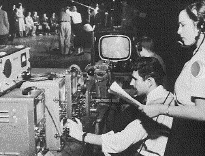
Photo by DuMont
A Concentration of Equipment |
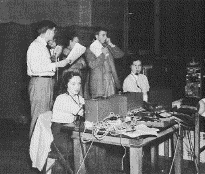
Photo by Robert Finver
A Concentration of Thought |
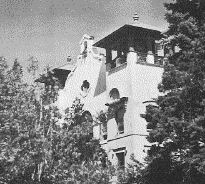
The College, Wired for Video
Photo by DuMont
Page Six
|
| |
|
WHO PLANNED IT?
A. It Goes a Long Way Back
Something was said about it as long ago as September, 1950, when the
first talks got under way, exploring the possibility of cooperation
between the College and the Allen B. DuMont Laboratories, Inc.; Dr. Harry
A. Sprague, then President of the College, and Dr. Allen B. DuMont had a
conversation of which there is no record. It may have been mentioned then.
On September 26, 1950, Mr. H. E. Taylor, Jr., and Mr. Francis Rice,
representing the Laboratories, and Dr. Harry A. Sprague, Dr. E. DeAlton
Partridge, Mr. Edgar C. Bye, and Mr. Edward C. Rasp, Jr., representing the
College, held a full-dress talk on the subject, reaching a number of
agreements.
On October 18, 1950, there was formed at the College a Committee on
Television in Education. Dr. Herbert B. Gooden was elected Chairman. This
committee immediately laid plans for a credit course in television on the
undergraduate level; and began to talk about the possibility of arranging
broadcasts of school lessons from our campus. In preparation for this and
other related enterprises, Mr. Edward C. Rasp, Jr., of our faculty, was
designated to receive intensive training generously offered by the DuMont
Laboratories and their TV Station W ABD.
B. But the Plans Were Made in 1952 In January of this year, Dr. E. D.
Partridge, college President, and Mr. Edward C. Rasp, Jr., Director of the
Television Project, invited Dr. Clarence E. Hinchey and Mr. Henry T.
Hollingsworth, Superintendents of Schools of Montclair and Bloomfield,
respectively, to cooperate in planning a full day's educational broadcasts
to the schools of either or both of these towns. Both men accepted, and
the Bloomfield-Montclair Television Committee was formed, to proceed with
plans. The Committee is composed of the following teachers from these
towns.
· BLOOMFIELD-Franklin Alliston, Regina Garb, John T. Jordan, Mary
Moran, Charles Morgan. Fred Grill is the AudioVisual Coordinator for this
group.
· MONTCLAIR - Morris Goldberger, Raymond Hugg, Donald Knowlton, Teresa
Relihan, Emmett Riley, Louise S. Roe, Elizabeth Smith. Dr. E. Winifred
Crawford is the Audio-Visual coordinator for Montclair.
· Mr. Rasp met with this Committee regularly. Mr. L. Howard Fox and
Mr. Walter Kops did likewise. Dr. Partridge and the two Superintendents
sometimes participated in the planning.
C. Truly A Cooperative Enterprise
· Here were teachers from two neighboring towns working together on an
educational problem, and each group making its contribution.
· Here was a Teachers College going to nearby classrooms to ask,
"What are you teaching?" and "How can we help you?" ·
Here was an educational experiment being carried out in more than a dozen
schools at once, in the open, and taking genuine risks of failure.
· Here were modern science, modern industry, the modern school systems
of two fine communities, and an earnest group of educators exploring
together the possibilities of a new medium of education.
Page Seven
|
| |
| WHO DID THE WORK?
A. The Director and his Staff
Mr. Edward C. Rasp, Jr., Director of the Project, is the one person on
our campus who has a well-rounded training in all phases of television
work. Before the Project began, he was a teacher of speech and Director of
the Audio Laboratory on our campus. Mr.
Rasp is a graduate of the College, and holds a Master's Degree in
Education, also secured here. His Master's thesis was a brilliant piece of
work: a documentary sound motion picture embodying a study of the values
of field trips in secondary education. His training in television work was
secured in the DuMont Laboratories and in their television studio, W ABD,
at their expense.
. With his technical training, Mr. Rasp has had to carry the greater
part of the work of this experiment. Long before April 30th, he moved the
plans along from week to week. And on the day itself, he was on the floor
constantly, and seemed to be everywhere. His was the greatest single
contribution, in every phase of this very complex enterprise.
. Associated with Mr. Rasp in developing the plans for the day, and in
training and coaching the college students who were to carry them out, was
Mr. L. Howard Fox, Chairman of the Speech Division. One of
three instructors of the Television Workshop. Mr. Fox found himself
giving much of his time to these fascinating groups; meeting them in
"idea sessions", then helping them to develop their ideas into
program scripts, and training them in the techniques necessary to staging
their programs. Mr. Fox became a television technician whether he wanted
to or not.
. The third member of the "television faculty" is Mr. Walter
Kops, of the Social Studies department. Interested in audiovisual aids,
Mr. Kops has worked enthusiastically for the television project from the
beginning. In the events of April 30th, he found a full outlet for his
interest and his energy.
. These three men participated in all of the planning; made most of the
decisions concerning production; and actually put their shoulders and
their backs into the hard work that had to be done in preparation for the
broadcast, and that had to be continued under trying conditions all
through the long day of programs. |
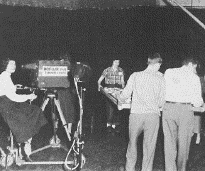
Photo by Roberl Finver
Workshoppers Lending a Hand
Page Eight |
| |
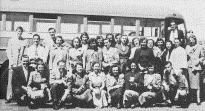
Photo by Churchill Clark The Workshop Group Takes to
the Road
B. The Television Workshop Group
This is the group of twenty-nine college students, twenty-two of them
girls, who handled the cameras and the cables and the lights and the sound
apparatus, and directed and produced the programs. But long before that,
they moved their studio with all of its equipment from a basement room at
the west end of the building, to a first-floor room at the east end. They
moved the scenery, set up the flats, hung the drapes, rehearsed their
"shows", in which they took part whereever they were needed; and
drilled themselves in all operations until they were sure of success. And
still more, when the day was over and the weary spectators went home to
rest, the Workshop crew dismantled the studio and put everything back
where it belonged, so that physical education classes could meet in the
gymnasium the next morning.
. Heroes of the day? Yes, but they were a pretty sweaty crew, and their
hands and faces were dirty, and they were simp]y DEAD for sleep, before.
they got into bed that night.
· The Director and his staff wou]d say that these are the ones who
really did the work of the day.
· The 29 TV Workshop students follow:
Joan Amorison Ken Burnett Louis Busch Willa Ann Calvert Jack Carroll
Emil Cebulski Churchill Clark Joan Dittig Eileen Dolch Kathy Douglas
Barbara Flatley Gloria Giamo Ben Harris Nannette Harris Catherine Howard
Lynn Jacoby Norma Jean Jaeger Sandra Lerner
Evan Maletsky Robyn Mendelsohn Maxine Minkowitz Mary Oliger Shirley
Page
Grace Rainey
Carol Rous
Harriet Schmidt Diane Schorn Theodore Sokolowski Betty Ann Thomas
· 28 of these students are in their sophomore or junior years in
college. One is a graduate student. There are no senior students, as most
of our Seniors are involved in supervised student teaching, away from the
College, during the spring semester.
· It should be noted that these people were the complete "studio
crew." We employed no technical help. Did they know how to do their
jobs ? Yes, they have learned how, during their experience in one or
another of the two-point courses in which they have done all of these
things before.
· College students learn these jobs very quickly. Almost from the
first day, they get quite good results from television apparatus. · In
situations in which there is a seriousminded learning group, the expense
of maintaining a studio crew can be held down considerably.
C. The Television Committee
Faculty members of the Executive Board of the Television Committee took
pride in greeting visitors who came to the campus for this occasion.
Page Nine
|
|
|
|
|
|
|
|
|
|
|
|
|
|
|
|
|
|
|
|
|
|
|
|
|
|
|
|
|
|
|
|